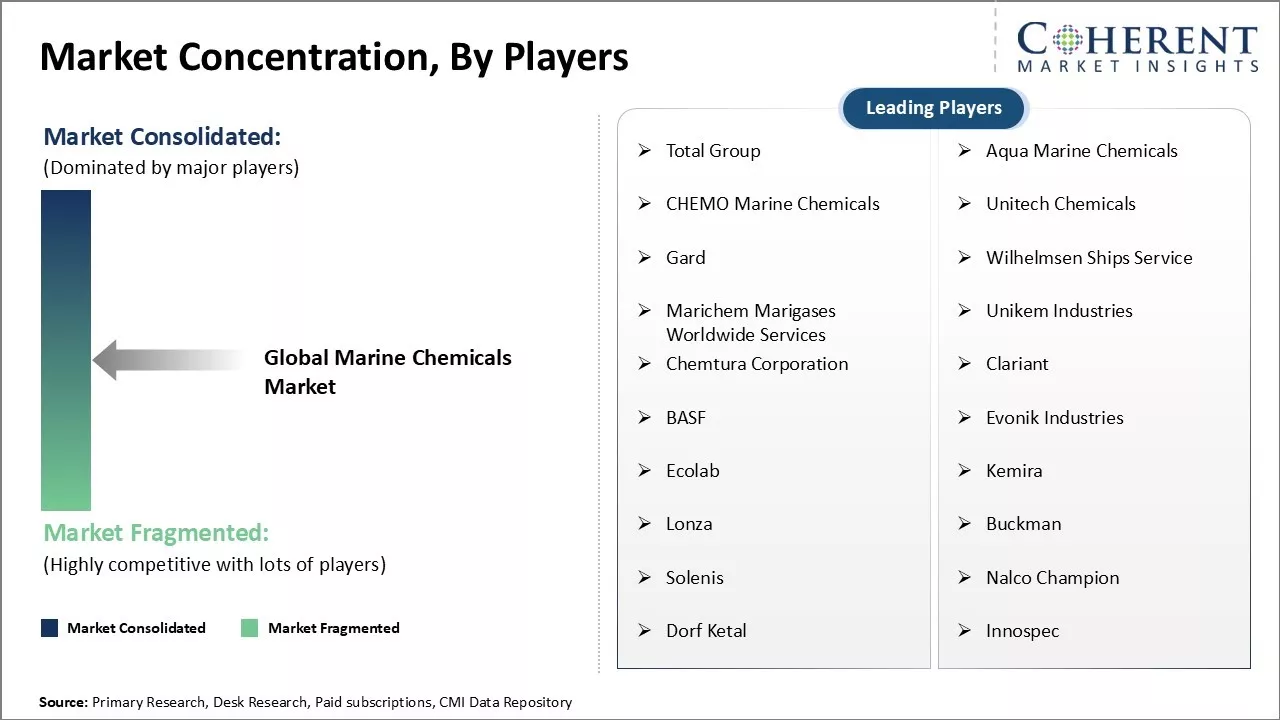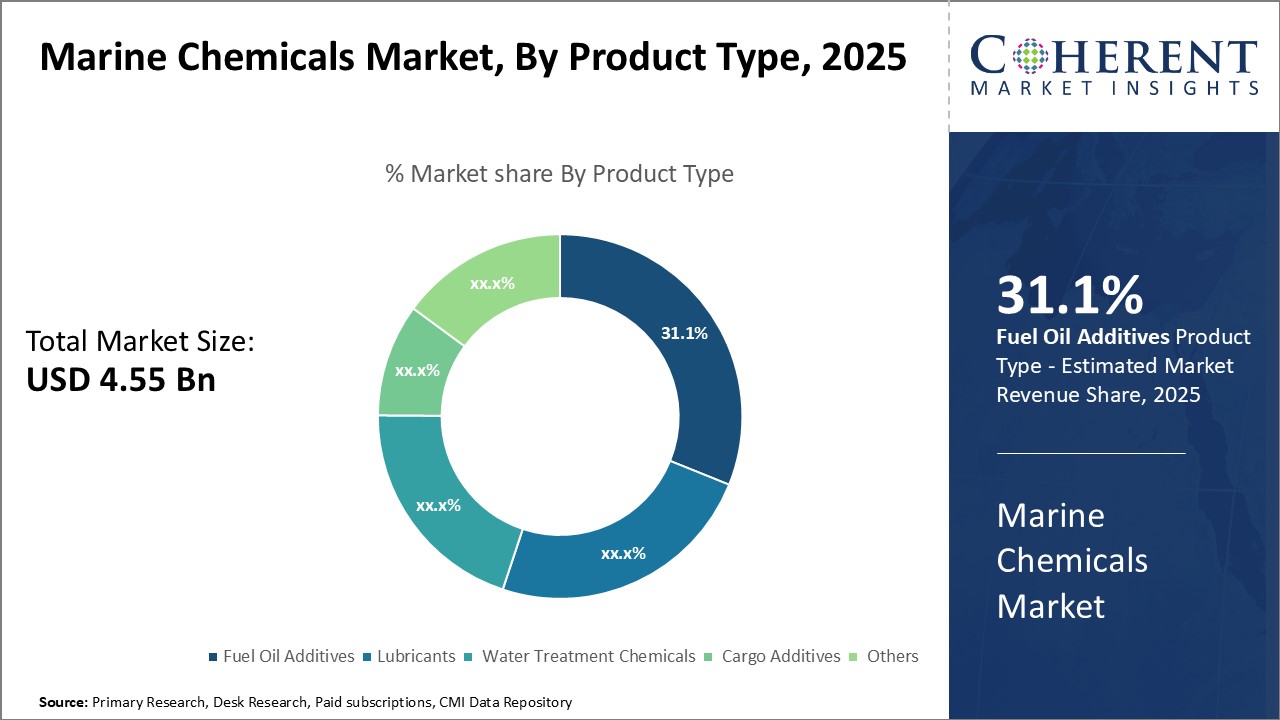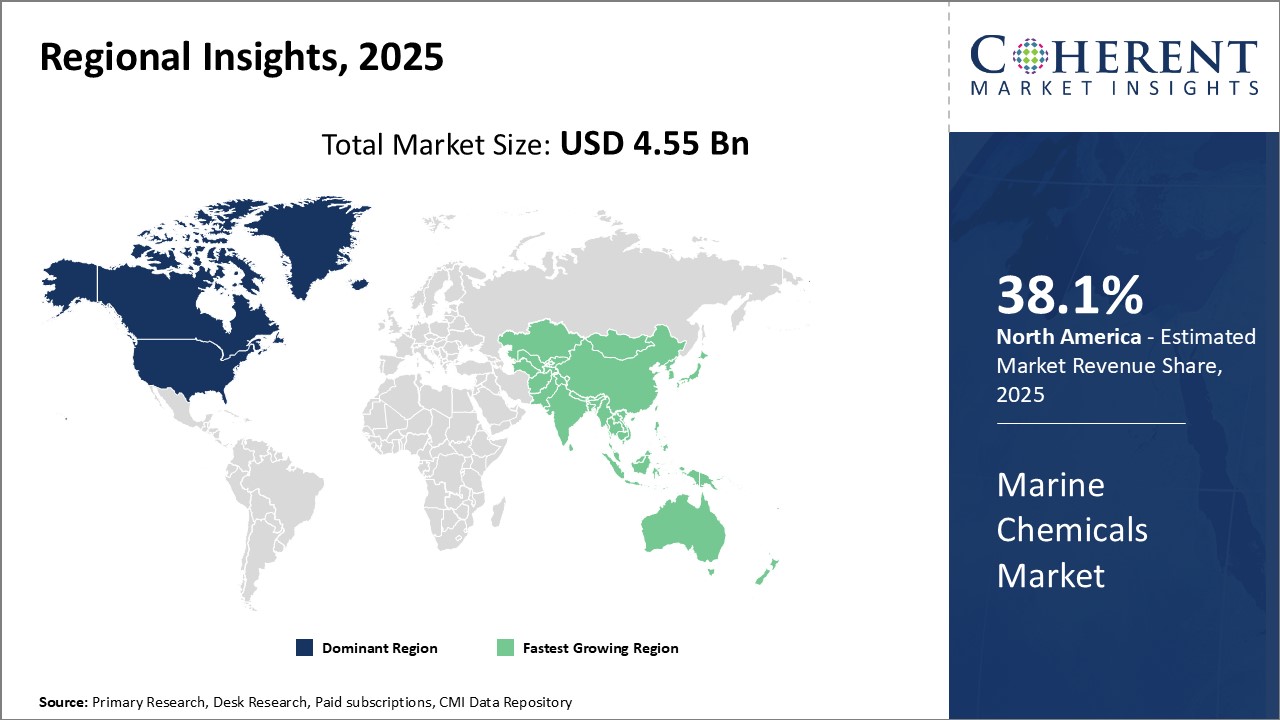The global marine chemicals market is estimated to be valued at USD 4.55 Bn in 2025 and is expected to reach USD 6.58 Bn by 2032, exhibiting a compound annual growth rate (CAGR) of 5.4% from 2025 to 2032.

Discover market dynamics shaping the industry: Request sample copy
Increasing sea-borne trade activities and expansion of the shipping industry are driving the demand for marine chemicals. In addition, strict environmental regulations regarding sulfur emissions from ships and growth in offshore exploration and production activities will further aid the demand for marine chemicals. However, volatility in raw material prices may hamper the market growth during the forecast period. The development of bio-based and environment-friendly marine chemicals is expected to provide new opportunities for the players operating in the global marine chemicals market in the coming years.

Get actionable strategies to beat competition: Request sample copy
Growth in maritime trading activities
As trade between countries has proliferated over the years, maritime transportation has become an indispensable part of the global supply chain. Shipping lanes carry over 80% of global trade, moving commodities, components and finished goods from manufacturers to consumers across vast distances. With international commerce witnessing sizable gains in recent times on the back of globalization and emerging market growth, the volume of cargo carried by sea has registered consistent increases. This rising tide of maritime trade has major implications for the marine chemicals industry.
As vessels transport greater amounts of freight across oceans and seas, there is a amplified need for a variety of chemicals that help keep shipping operations smooth and efficient. Marine biocides are a necessity to prevent organisms from clinging to ship hulls and potentially slowing them down. Fuel additives are another important requirement that enhances engine performance, lowers emissions and ensures combustion of cheaper grades of bunker fuel. Rust preventives and corrosion inhibitors play a key role in shielding cargo holds and engine parts from the corrosive effects of saltwater. Further, cleaning products are in high demand to maintain hygiene on-board and clean spills and residues after unloading cargoes.
An assortment of other marine chemicals such as oils, greases, paints, and coatings are indispensable for the upkeep of marine assets. They aid in prolonging equipment life and reducing maintenance downtime. Moreover, recent regulations for limiting pollution have boosted the market for chemicals that aid compliance, like exhaust gas cleaning systems and ballast water management solutions. These solutions ensure invasive species are not transferred between marine ecosystems through ballast water discharge from ships. Significant investments are also being made by shipping companies to upgrade fleets and vessels, driving requisites for specialized chemicals.
Amid predictions of continued globalization and the expanding "Blue Economy", international merchandise trade looks set to rise substantially in the coming years. This bodes well for shipping lines and logistics companies, translating to increased operational needs for marine chemicals. As maritime routes integrate deeper into international supply chains, adequate protections and maintenance through chemicals will be paramount to support uninterrupted cargo movements. Rising cargo volumes will necessitate bigger fleets and newer ships, further expanding the captive customer base for players in this industry. Overall, robust expansion of world trade and shipping should sustain strong demand drivers that augment the growth of the marine chemicals market.
Key Takeaways from Analyst:
The significant growth of the shipping industry will be a key driver for the marine chemicals market. As international seaborne trade increases with the rise in globalization and outsourcing of manufacturing, demand for bulk carriers, tankers, and container ships is projected to surge. This will necessitate greater consumption of various marine chemicals used for maintenance and operations of vessels.
However, stringent environmental regulations regarding the discharge of chemicals at sea might act as a restraint on the use of certain products. Regulations tightening pollution control are expected to spur the demand for advanced bio-based and eco-friendly chemicals. Ship owners will be willing to pay more for greener chemicals that help comply with stringent norms.
The North America region is likely to dominate the global marine chemicals landscape over the next decade owing to increased shipbuilding activities. Major ports are witnessing extensive infrastructure expansion to handle rising maritime trade. This presents opportunities for marine chemicals suppliers to tap the growth in these emerging markets.
Market Challenge - Fluctuations in crude oil prices
One of the key challenges faced by the global marine chemicals market is the fluctuations seen in crude oil prices over the past few years. As crude oil is the major feedstock for producing marine chemicals, uncertainty in crude oil rates directly impacts the operating costs and margins for marine chemicals manufacturers. Steep declines in crude oil prices in 2015-16 squeezed profitability across the industry as production costs did not reduce in tandem. Similarly, price volatility amid geopolitical tensions and supply disruptions has made it difficult for companies to implement long-term strategic plans and pricing strategies. Any sharp increase in raw material costs can significantly reduce the competitiveness of marine chemical products in international markets. Manufacturers find it challenging to anticipate demand and maintain stable supply chains amid unpredictable changes in input costs. While efforts are ongoing to reduce dependency on crude oil through investments in alternative feedstock, crude will continue playing a dominant role in the foreseeable future, keeping the industry susceptible to oil market downturns and fluctuations.
Market Challenge - Rising demand for bio-based chemicals
One major opportunity for the marine chemicals market is the rising demand for bio-based and green chemicals obtained from renewable feedstocks. With growing international commitment towards reducing carbon footprint, players in the marine industry are under increasing pressure to develop and adopt sustainable chemistries. Various countries and ports have stringent regulations pertaining to the usage of chemicals and emissions from ships. This is driving the demand for bio-derived additives, lubricants, cleaning products and other marine chemicals. Their production involves lower greenhouse gas emissions and is perceived to be more environmentally friendly compared to petroleum-based equivalents. Furthermore, initiatives targeting sustainable shipping and technology development are encouraging greater use of bio-feedstock within the marine industry. Leading manufacturers have started building capabilities in green chemistry and investing in relevant research to cater to this lucrative segment. The evolving regulatory scenario and focus on eco-friendly innovations present a major opportunity for marine chemicals producers to tap into the sustainable shipping trend.

Discover high revenue pocket segments and roadmap to it: Request sample copy
Insights by product type: Growing demand for optimizing fuel efficiency
In terms of product type, fuel oil additives is expected to contribute 31.1% share of the market 2025. Fuel oil additives represent the largest segment in the global marine chemicals market due to their wide application in improving fuel quality and optimizing engine performance. Shipping companies are under constant pressure to reduce fuel costs which account for a major portion of their overall operating expenses. Fuel oil additives help improve the efficiency of marine diesel engines and boilers by preventing corrosion, deposits, and wear & tear. They minimize sludge formation, enhance lubricity, and stability of fuels. This enhances combustion and thermal efficiency of engines, thereby lowering bunker fuel consumption.
Rising global seaborne trade volumes have significantly increased the demand for marine transportation. With fuel costs directly impacting the profitability of vessel operators, there is growing focus on retrofitting existing fleet with advanced engines incorporating latest pollution norms. Fuel additives play a vital role in ensuring optimal performance of these high-pressure common rail fuel injection systems and electronic control units. Stringent environmental regulations regarding sulfur emissions from marine fuels have also spurred the need for additives that can lower the sulfur content of heavy fuel oils. The segment is anticipated to continue dominating the marine chemicals market owing to benefits such as improved engine reliability and measurable savings on fuel bills.
Insights by application: Elevated marine trade activities
In terms of application, shipping is expected to contribute 45% share of the market in 2025. The application segment for shipping accounts for the major share of demand for marine chemicals globally. This can be attributed to the enormous growth in international seaborne trade volumes over the past few decades. Major fractions of global commodity transportation between regions are undertaken through bulk carriers, oil tankers, container ships, and other cargo vessels. With rising import/export of crude oil, iron ore, grains and manufactured goods, shipping companies continue to expand their fleet size as well as upgrade existing tonnage.
Proper maintenance and protection of vessel hulls along with cargo hold coatings require a continuous supply of anti-corrosives, boilers water treatments and cleaners & degreasers. Rising ship speeds correlate with increased mechanical stress and wear & tear of engine parts that necessitate regular application of lubricants and corrosion inhibitors. Strict emission regulations have stimulated the use of exhaust gas cleaning chemicals to comply with sulfur oxide norms. In addition, marine biocides are indispensable for preventing biofouling during long voyages and in idle or slow steaming conditions. Thus, heightened marine trading activities present a steady source of revenue for chemical manufacturers in the shipping applications segment.

Need a Different Region or Segment? Customize now
North America dominates the global marine chemicals market currently. The region is expected to account for 38.1% of the market share in 2025. The region accounts for the largest share due to presence of majority of leading chemical manufacturers and suppliers. Several new transport projects such as dredging of Panama Canal has further augmented product demand from the shipping industry. Also, trade activities in Great Lakes and waterways support market growth. Stringent environmental regulations regarding ballast water treatment have boosted the demand for biocides and other disinfectants.
Asia Pacific is recognized as the fastest growing regional market for marine chemicals. Rapid expansion of shipping fleet along with increase in overseas trade drives the chemical consumption. Major economies like China and India are investing heavily in port infrastructure development which spurs opportunities. Additionally, policy initiatives by governments in the region towards facilitating coastal trade would benefit the adoption of marine treatment products. Growing maritime tourism industry, especially in Southeast Asian countries is another factor fueling the APAC market expansion.
Marine Chemicals Market Report Coverage
| Report Coverage | Details | ||
|---|---|---|---|
| Base Year: | 2024 | Market Size in 2025: | USD 4.55 Bn |
| Historical Data for: | 2020 To 2024 | Forecast Period: | 2025 To 2032 |
| Forecast Period 2025 to 2032 CAGR: | 5.4% | 2032 Value Projection: | USD 6.58 Bn |
| Geographies covered: |
|
||
| Segments covered: |
|
||
| Companies covered: |
Total Group, Aqua Marine Chemicals, CHEMO Marine Chemicals, Unitech Chemicals, Gard, Wilhelmsen Ships Service, Marichem Marigases Worldwide Services, Unikem Industries, Chemtura Corporation, Clariant, BASF, Evonik Industries, Ecolab, Kemira, Lonza, Buckman, Solenis, Nalco Champion, Dorf Ketal, and Innospec |
||
| Growth Drivers: |
|
||
| Restraints & Challenges: |
|
||
Uncover macros and micros vetted on 75+ parameters: Get instant access to report
*Definition: The global marine chemicals market consists of chemical products that are used for various applications across the shipping industry. These include cleaning chemicals, rust removal solutions, marine lubricants and other industrial fluids, antifouling coatings, biocides, and water treatment compounds. The marine chemicals help provide corrosion protection, control microbial growth, remove slime and algae from ship hulls, clean cargo holds and decks, treat ballast water, and perform other functions that are important for the safe and efficient operation of vessels.
Share
Share
About Author
Yash Doshi is a Senior Management Consultant. He has 12+ years of experience in conducting research and handling consulting projects across verticals in APAC, EMEA, and the Americas.
He brings strong acumen in helping chemical companies navigate complex challenges and identify growth opportunities. He has deep expertise across the chemicals value chain, including commodity, specialty and fine chemicals, plastics and polymers, and petrochemicals. Yash is a sought-after speaker at industry conferences and contributes to various publications on topics related commodity, specialty and fine chemicals, plastics and polymers, and petrochemicals.
Missing comfort of reading report in your local language? Find your preferred language :
Transform your Strategy with Exclusive Trending Reports :
Frequently Asked Questions
Joining thousands of companies around the world committed to making the Excellent Business Solutions.
View All Our Clients
US Reciprocal Tax Impact Analysis On Marine Chemicals Market
Stay updated on tariff changes with expert insights and timely information